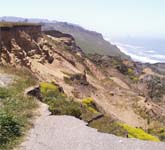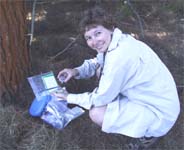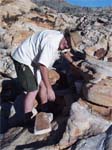- Creating
a Geocache
- Building,
Placing, and Hiding
|

|
- Identify
a Unique Location
-
- One of the
reasons we like geocaching is that a cache
can take us somewhere we would probably miss
otherwise. Rather than choosing a popular
tourist location. Find a place off the beaten
path. Where are the places that the local
people love that aren't in the tourist
guides?
-
- As you
select your location, consider how people
will approach the area. Conservation is a key
philosophy of geocaching, so place your cache
where it will have minimal impact on the
nature. For example, rather than bushwhacking
for miles, place the cache a few yards from
an established trail.
|
You also need to consider the land itself. If the cache
is on private land, be sure to get permission. The best
place to locate caches is on BLM (Bureau of Land
Management) or National Forest land. In addition, since
National Parks and Monuments are specifically intended to
preserve natural and historical resources, it's best to
avoid these places. -
- Be creative, people have
placed caches on mountain tops and underwater. Although
you want a unique location, please keep it a safe
location.
-
- The location should be
extraordinary. In other words, the site might provide a
view of the ocean, an interesting rock formation, or a
beautiful waterfall. It could also be a place of
historical significance or cultural interest. Think
special. Think unique.
|
Select
a Good Container
Besides the
location, your other major decision relates to
the cache itself. The container is the key. It
should be made of the best material for the area
where it will be stored. Will your container get
hot, cold, or wet? All containers must be water
tight. Consider Rubbermaid plastic, ammo boxes,
and paint cans.
Your container
should be easy to open, but also easy to reseal.
One geocache was stored in a paint bucket and
they even provided a screw driver to help open
the lid!
Think about the
size of the container. It should be big enough
to store oversized treasure, but small enough to
be easily hidden.
|

|
- Choose
the Cache Contents
-
- Log
book. Every cache needs a log book. It
can be a small spiral notebook, sketchbook,
or even a leather journal. You'll want to put
information about yourself including your
contact information, your reason for
selecting the location, and the date you
established the cache. Also provide
guidelines for using your geocache. You might
also want to put information about nearby
attractions and coordinates to other
locations. Place the log along with a pencil
(pens will dry out or freeze) and sharpener
in a zip lock bag.
-
- Label the
Contents. There's a chance that an
"outsider" might stumble upon the cache. Be
sure to label the outside. Also put a copy of
the geocaching
letter
inside your cache so people will know the
purpose of the cache. You might also include
a list of contents.
-
- Treasures.
You can choose any type of treasure that fits
you personality. It may be things you find
around the house or trinkets that you buy.
Items such as old CDs, paperback books,
matchbox cars, toys, key chains, and hiking
tools work good. Keep it cheap. Your whole
cache including the container should be less
than twenty bucks. Put things in zip lock
plastic bags for extra protection.
-
- Remember
that the treasure will be stored for a long
time so avoid items that might spoil such as
food, things that might melt, or things that
could be dangerous or illegal such as
ammo.
|

|

|
- Incorporate
Fun Activities
-
- Adopt a rock
family, swap a CD, or take a picture. Think
about fun activities to incorporate into your
geocache. One geocache provided a log book
and pet rocks. Your mission was to adopt a
rock family and place them in a geocache at
another location. Another geocache provided
postcards that could be sent to friends.
-
- Many people
include a disposable camera in their cache.
People are asked to take a picture and write
in the log. When the camera is full, they ask
you to mail them the camera or let them know
and they'll pick it up. Then, the pictures
are posted on the web. Fun!
Brainstorm some
unique activities or treasures you might
incorporate into your cache.
|

|
- Locate
a Good Hiding Place
-
- Once your
container is ready, you need to pick the best
location to hide your cache. It should be
placed where people would miss it unless
they're specifically looking for the cache.
Inside a rock crevice, under a bush, or
inside a jumble of logs works well. In some
cases, you might have to build a shelter. For
example, in the desert you might create a
rock tower to house the cache.
-
- There's a
fine line between a good hiding place and a
place that no one will ever look. Don't bury
your cache or hide it such that it can't be
found. Finally, don't hide it in a dangerous
location or somewhere that will destroy
nature. In other words, the top of a tree,
over the edge of a cliff, or in a bird's nest
are poor choices!
-
- Remember,
geocaching is about discovery. Make it
fun!
|

|
- Provide
Good Directions
-
- Although the
fun of a geocache is in the discovery, you
need to provide enough information to
interest readers and get them to the cache.
Begin with an accurate set of coordinates. As
you set your cache be sure to double check
the location with your GPS device. Also, if
you think people might have difficulty
finding the cache, consider identifying
waypoints or key features along the route.
For example, the picture on the left shows a
rock that points directly at the cache.
Fun!
-
- Before you
leave the site, write an accurate description
of the area. Also consider things that might
be useful clues such as landmarks or general
directions. When you're ready, give the cache
a name and enter it at the report
a cache
section of the geocaching
website.
|
- For more information
about geocaching, check out Geocaching's Guide
to Creating and Hiding a
Cache
page.
-
-
Created by Annette
Lamb
and
Larry Johnson,
07/01.
|